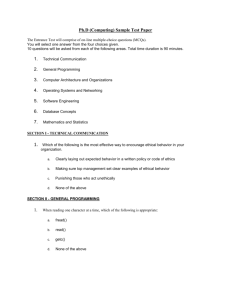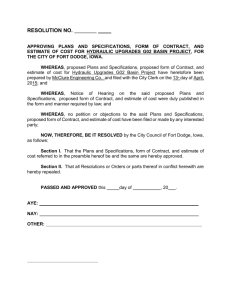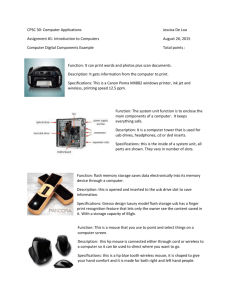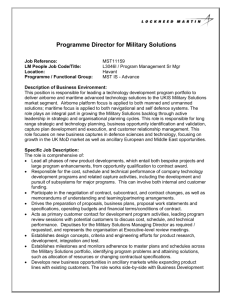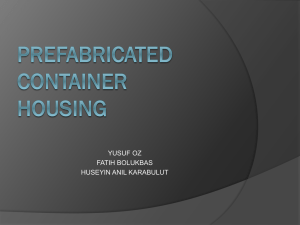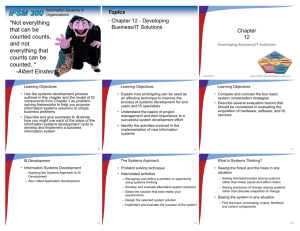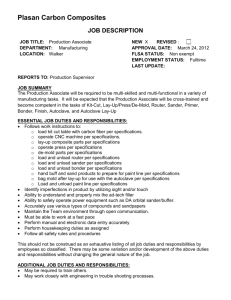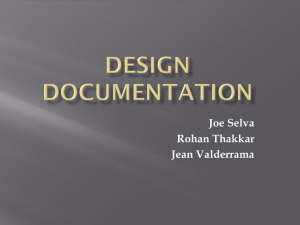Dr Mulenga
advertisement
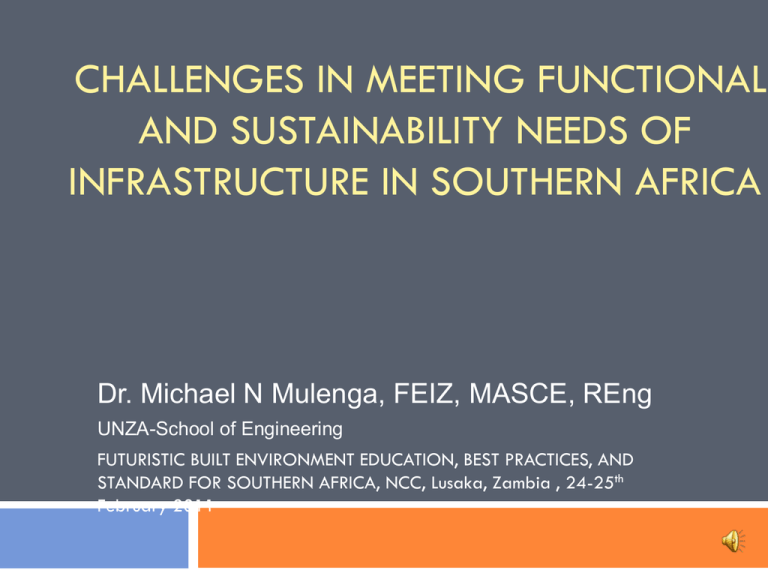
CHALLENGES IN MEETING FUNCTIONAL AND SUSTAINABILITY NEEDS OF INFRASTRUCTURE IN SOUTHERN AFRICA Dr. Michael N Mulenga, FEIZ, MASCE, REng UNZA-School of Engineering FUTURISTIC BUILT ENVIRONMENT EDUCATION, BEST PRACTICES, AND STANDARD FOR SOUTHERN AFRICA, NCC, Lusaka, Zambia , 24-25th February 2011 Overview of Presentation 1. 2. 3. 4. 5. 6. Introduction Conception, Design and Specifications Materials of Construction Construction, refurbishment and maintenance of constructed facilities Monitoring, Evaluation and Feedback Conclusions and Recommendations Introduction Zambia-Country Profile Landlocked country Land Area 752, 612 sq km Population 12.9 million Total Road Network 67,671 km Core Road Network 40,000 km Introduction (Cont’d) Southern Africa is endowed with large amounts of construction raw materials Manufactured materials such as structural and reinforcing steel, cement and masonry units are produced locally Zambia imports different various manufactured materials from the region and other countries Limited number of harmonized standards and codes of practice exist Conception, design and specifications Successful construction projects require a thorough thought process to ensure performance to expectations Concerted efforts are required between the various players (planners to designers and contractors) Poorly planned and executed projects can lead to disaster The design process should be subjected to a quality assurance plan to ensure responsibility, accountability and traceability. Conception, design and specifications (Cont’d) The specifications should be ‘green’ and should encourage innovation. New materials of construction and related practices can be promoted through intelligent specifications and advocacy. Issues of the Climate Change, for example, should be incorporated in our standards, codes of practice and specifications. Materials of construction The behavior of constructed facilities depends to a large extent on the materials that are incorporated in the construction. Basic materials such as the aggregates have to be blended and used in prescribed quantities Manufactured materials have to be used ingeniously to satisfy strength, functional and serviceability requirements. Use of novel materials of construction, such as composites, re-use and recycling of materials are all feasible options. Materials (Cont’ d) For cost effectiveness and sustainability, emphasis should be placed on effective use the locally available construction materials Standardization is key to promoting regional and international, bilateral and multi-lateral agreements that promote socio-economic developmental SADC and COMESA protocols emphasize ‘trade beyond borders’ maintenance of constructed facilities To meet present and future needs, as well as heritage requirements, novelty in design, construction and maintenance is required Education and Training and Research and Development (R & D) are major inputs. Strong partnerships are required amongst stakeholders, to achieve futuristic built-environment. Funding for Education, Training and Research & Development The efforts require sustainable funding and deliberate policies targeted at sustainable built environment. One way is to ensure that a percentage of each contract sum is channeled to education, training, research and development. Monitoring, Evaluation and Feedback There is need for monitoring and evaluation of the processes and the resulting constructed infrastructure. Mechanisms for feedback and updating of the codes have to be developed Information flow to end users should be efficient and effective, as demanded by the construction industry Corrective action and improvements can then be instituted in a timely manner. Conclusions and Recommendations Several materials of construction, from different sources are available on the Southern African market. There is need for harmonization of standards in Southern African Standardization is a means by which we can boost regional and international developmental initiatives ‘Green’ practices and innovation must be encouraged through intelligent standards, codes of practice and specifications, as well as advocacy. Conclusions and Recommendations (Cont’d) Topical issues such as Climate Change need be incorporated in codes and specifications development Robust Specifications should not be looked upon as ‘policing’ mechanisms, but rather ‘opportunities’ for innovation and sustainability. Funding and strong partnerships between players is absolutely essential THE END

